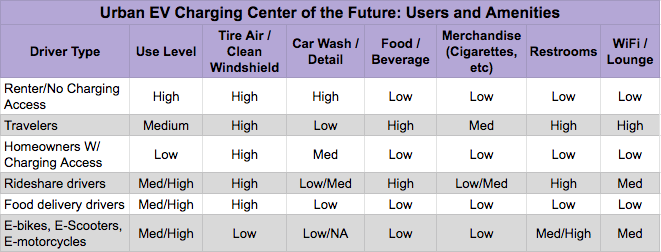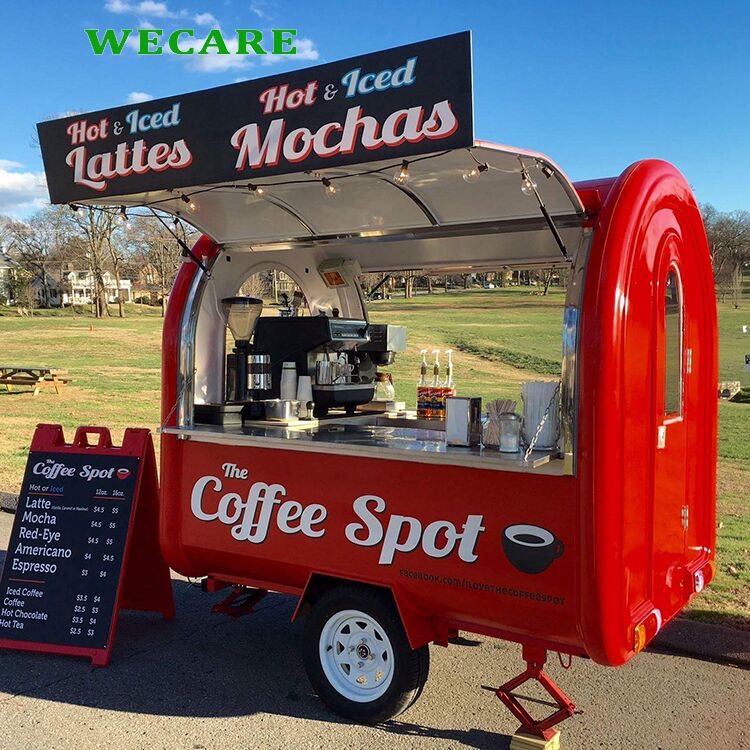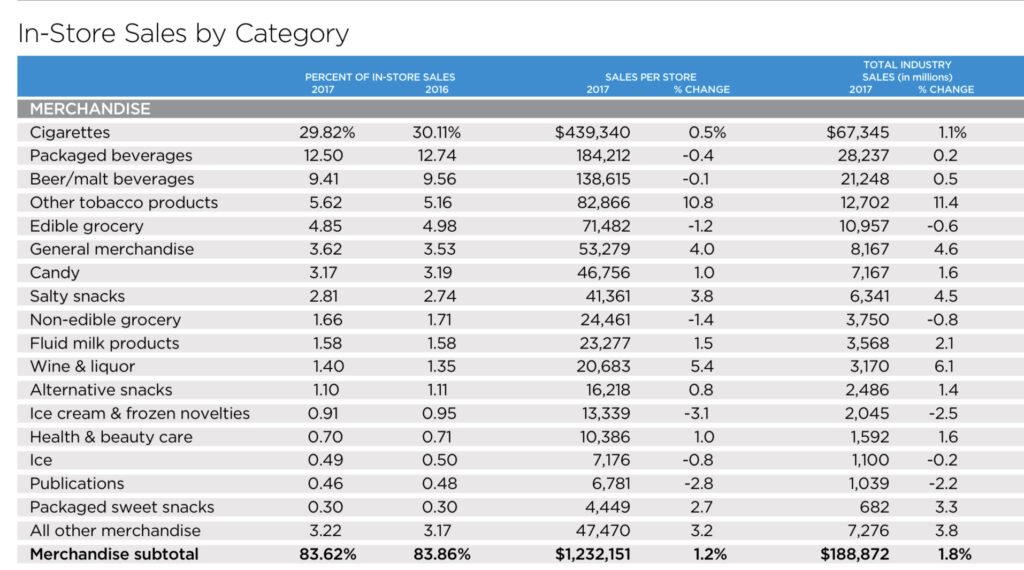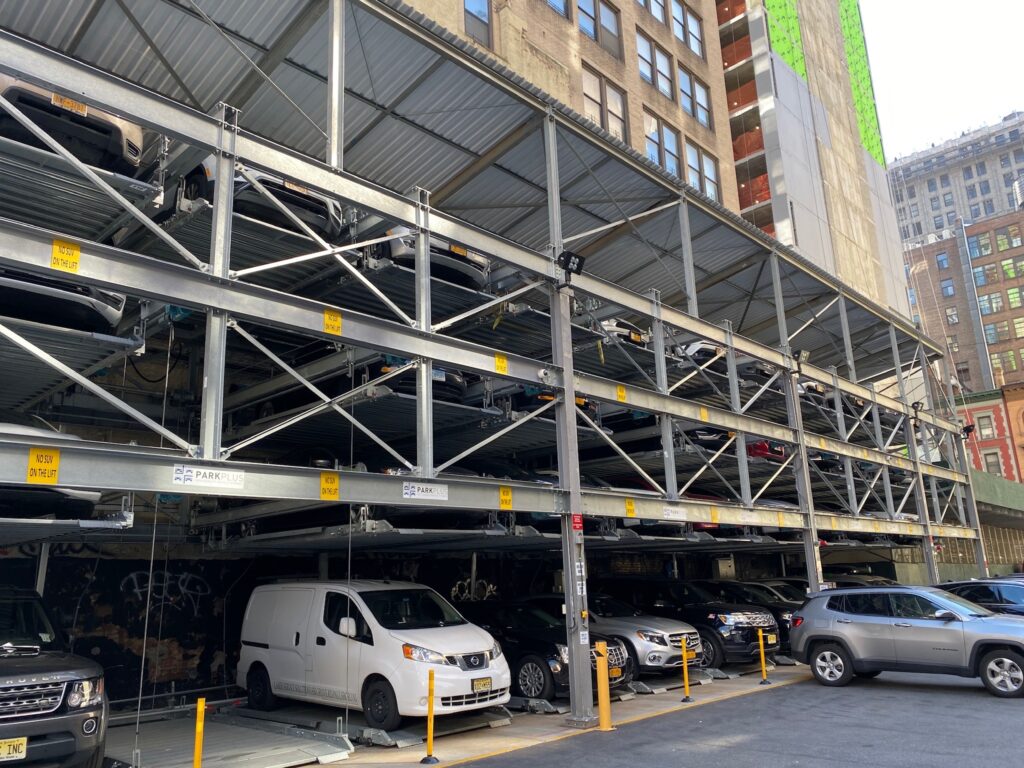Recently my wife came home from the grocery store and mentioned that the air pressure was low on the tires of our electric vehicle and asked me to “take care of it.”
And so the next day I ventured out to the local gas station I had been frequenting for years – before we switched to electric vehicles – and added air to the tires. I then left and went on to do some shopping at Trader Joes.
The last few years I’ve thought a lot about the future of gas stations as well as EV charging centers, but this recent experience got me thinking again about what the EV charging customer experience and related amenities and services might be like in the next 10 years.

Users/Use Cases for Urban Charging Centers
I’ve identified 5 primary users and use cases for urban charging centers and potential future incarnations that include various amenities and services. These are:
- Renters/Home Dwellers Without Charging Access: Renters, homeowners and others who don’t have regular and convenient access to charging where they live, will require a regular location to charge. Some of these EV drivers can charge at their workplace, but most will require and prefer a charging location location within a 5-10 minute drive from their home.
- Travelers: EV drivers who are visiting a city may not have charging access at their hotel if staying over or if they are just passing through or stopping briefly will need a place to charge.
- Rideshare drivers: As more and more rideshare drivers adopt EVs, they will need a place to charge up or add some range before their next fare or to reach home at the end of the day or night of driving.
- Food delivery drivers: No longer is food delivery primarily for pizza and Chinese food, but literally every kind of food imaginable. As these mostly independent drivers gravitate toward electric vehicles, many will be renters and students and require regular access to charging – and possibly other amenities.
- E-bikes, e-scooters, and electric motorcycles riders: Beyond cars and trucks, two-wheeled electric vehicles are rapidly gaining adoption and these urban charing centers could be convenient locations for riders to charge, grab a coffee and do some work using the lounge and WiFi.
Charging Center Dwell Times
Depending on the speed of the charging stations, number of available stations, range required of EV drivers, and their timing (in a hurry versus relaxing and eating while charging) most charging dwell times at these urban centers will range between 15 to 60 minutes. In the next 7-10 years, however, as the average BEV range is well above 300 miles and super fast charging becomes commonplace, the majority of these charging dwell times will probably be in the 10-30 minute range.
One nuance to these dwell times could be the cost of charging. A model that could emerge in the future is a pricing structure that is based on charging speed. If you are in a hurry you might pay a premium for super-fast DC charging speeds. Or if you can wait or want to enjoy a muffin, coffee and do some work using the lounge’s WiFi, you might opt for Level 2 or lower DC fast charging rates.
Likely and Possible Amenities and Services (Non Charging)
With the above use cases, user types and dwell times in mind, the following are likely or potential services, amenities, food and merchandise that might be available at urban charging centers:
Restrooms: Without a doubt, the number one amenity that is currently missing from the majority of public charging locations is a restroom. At locations near shopping malls, retailers, and restaurants you can take advantage of restrooms located in these nearby facilities. Depending on the distance to the restrooms, this can be quite an inconvenience, but it can also be an unfair use of a business’s facilities unless you also make a purchase.
Food service: Eating fast- or quick-service meals such as burgers, sandwiches, burritos or salads typically take about 15 to 30 minutes. This timeframe is roughly exactly the same as many charging instances and so co-locating with quick-service restaurants and coffee shops makes perfect sense. Unless a charging center has 100+ charging connections, it likely doesn’t make sense to have a dedicated food service operation at the charging center. But these centers could be good locations for food trucks to park.
Coffee bar: The coffee shop market in the US in 2018 was more than $45 billion and consumer’s appetite for coffee and tea drinks does not seem to be waning. Grabbing a coffee in the morning or latte in the afternoon is now a daily regimen for millions of Americans and is a logical amenity to have at large charging centers. Mobile coffee carts are probably a viable model to serve this market without requiring additional building space and overhead. The cart below advertised on Alibaba costs around $2,500.

Air for tires: As mentioned in the opening of this article, air for your car’s tires is a common need, often a few times per year. With EVs requiring less service than ICE vehicles and not needing gas, where will EV drivers find air filling stations? While some gas stations charge for filling tires with air, this feels more like it would be a free amenity at most charging centers.
Self-service vacuum machine: While not a high-demand or critical amenity, accessing a high powered vacuum while your EV charges is an efficient way to spend 5 to 10 minutes and a few dollars. With margins very low on electricity and charging, offering self-service vacuum equipment could be a decent way to improve the profitability of EV charging stations for operators.
Vending machines/Packaged food items: Vending machines are likely an ideal scenario for EV charging stations as they don’t require on-going human staffing. As self-service machines, they just need product refilling, money collection and maintenance by the third-party vending machine service organizations. I’ve seen this model work at the Tesla Kettleman City Supercharger lounge which has several vending machines that have everything from coffee to snacks to sandwiches.
The one obvious key requirement is that the vending machines need to be enclosed in a building and likely with a passcode to protect the machines from the elements and being vandalized. Like the vacuum service, vending machines can provide incremental revenue and profit margin on top of that for the charging services.
For reference, probably about half to two-thirds of the items sold inside a gas station convenience store could also be sold via vending machines. But this sales volume also speaks to why convenience stores will likely soon add EV charging stations once mass market adoption occurs.

Car wash and detailing services: Hand car wash, waxing and detailing services would seem to be an ideal service fit while a car is charging for 15 to 30 minutes. Look to mobile car wash and detailing services to set up shop at very large charging centers in the coming years.
Light maintenance: Because electric vehicles require very little maintenance there is little reason to bring your vehicle into a dealer or auto repair shop. But there are minor maintenance and repair needs such as windshield wiper replacement, tire rotation, and brake replacement that will need to be done every few years. These minor services along with light body work and cracked windshield replacement could easily be done by mobile repair services that co-locate at large charging centers.
WiFi: Most coffee shops and many quick-service restaurants offer free WiFi for customers. Sometimes a password is required so that only paying customers can use the WiFi. For larger EV charging centers, and especially those with a lounge or some type of seating area (not including the car itself), WiFi seems like it should become standard offering. Perhaps like many hotels, standard speed is free but superfast WiFi has a fee.
Lounge: My favorite charging station location is the Kettleman City Tesla Supercharger because of its lounge and amenities. On our trips to and from Southern California I always plan our charging stops around this location because it is such a great experience. Tesla has not opened a second lounge anywhere in the world as far as I know and I’m not aware of any other similar lounges located at charging centers. Lounges in urban centers make obvious sense for home office workers and gig-economy workers.

The key for lounges is obviously having a high-volume of charging traffic to justify the building, but also the location and services that support the need for a lounge. With the right amenities such as clean bathrooms, WiFi, workstations and a coffee bar – urban lounges could make sense. A special use case for these lounges would be for ridesharing drivers at locations near airports and other high-use ridesharing areas.
Convenience Stores (Gas Stations) Poised Well For the Future?
If the services, food, amenities and merchandise described above sound like the current incarnations of combo gas stations and convenience stores, you would be correct. The key differences being:
- While most convenience stores offer coffee, hot dogs, and other hot foods and beverages they don’t compare in quality to coffee bars and quick-service restaurants.
- Most urban convenience stores do not offer WiFi and seating or lounges, whereas travel centers along major interstates may offer both seating and WiFi.
- Years ago gas stations were actually known as service stations but over the years they morphed into convenience stores and deemphasized auto services. The exception seeming to be independent gas stations that offer repair, tune-up and smog check services.
Mobile Auto Service “Food Trucks”
Two emerging trends in disparate industries could end up finding homes at EV charging centers and merging into a new concept – the “mobile auto service truck.”
With an estimated 4,000 food trucks, the US market is now over $1 billion according to market research firm IBISWorld. These restaurants on wheels often move around to different locations and promote their locations on social media, or may park in the same location(s) on a regular basis.
Large EV charging locations with say a few dozen or more connections could become regular destinations for food trucks in the future. But the concept of mobile food service could and is being replicated in areas such as windshield replacement and mobile car washing and detailing. Spiffy is an example of one such service that offers mobile washing and detailing services. It isn’t hard to envision these companies setting up shop at busy charging centers where EV drivers would coordinate charging their EV with a wash and detail.
On the maintenance side, mobile auto service trucks might set up shop at charging locations to provide the following:
- Windshield wiper replacement
- Tire rotation
- Brake replacement
- Light body work
- Cracked windshield replacement
Parking and the Car “Volume and Turnover” Challenge
One of the keys to the gas station/convenience store business is the volume of business and constant turnover of vehicles every 5-10 minutes. During morning and evening commute times, gas stations likely have high utilization, versus the middle of the day. But the key difference between filling up for gas and charging EVs is the ability to churn more customers through at a gas station.
Assuming 100% utilization, and 8 about minutes per customer a gas station with 12 pumps could in theory see about 90 customers an hour. In contrast an EV charging center with an average of 20 minutes per charge and 12 connections would see only 36 customers per hour.
As a result adding additional services and amenities will likely be key for convenience stores to maintain margins and revenue in the future. One way to do this is to increase the available charging connections in the same available space as in a gas station. In the future we might see a move to parking lifts like you see in space constrained Manhattan. I can envision EV parking lifts that can stack multiple EVs and charge all of them at the same time.

Today most EV charging locations are bereft of any amenities and services which provides an inferior customer experience versus stopping at a convenience store for gas. The key open question is will the major charging networks expand beyond just offering electricity, or will the major convenience store operators simply evolve and add EV charging in addition to, and eventually replacement of gas pumps.
The next 10 years of transition should be quite interesting. Let me know what you think in the comments below.

